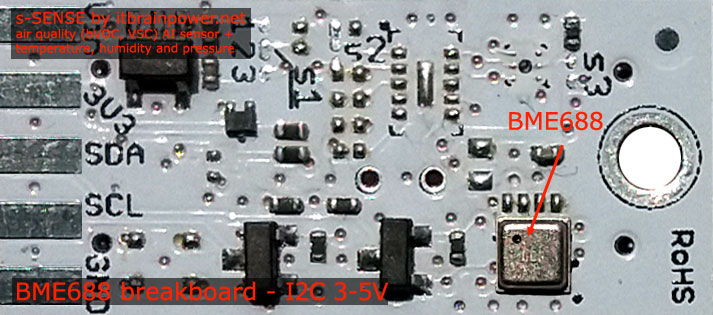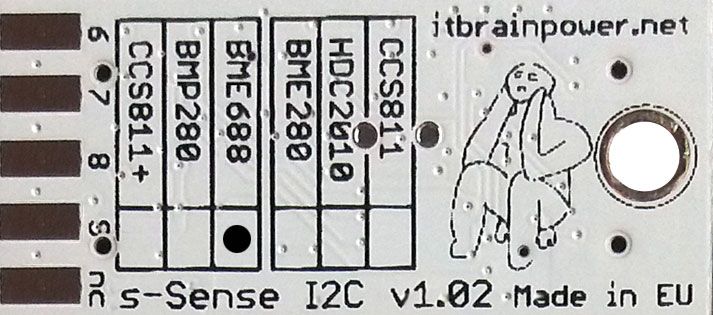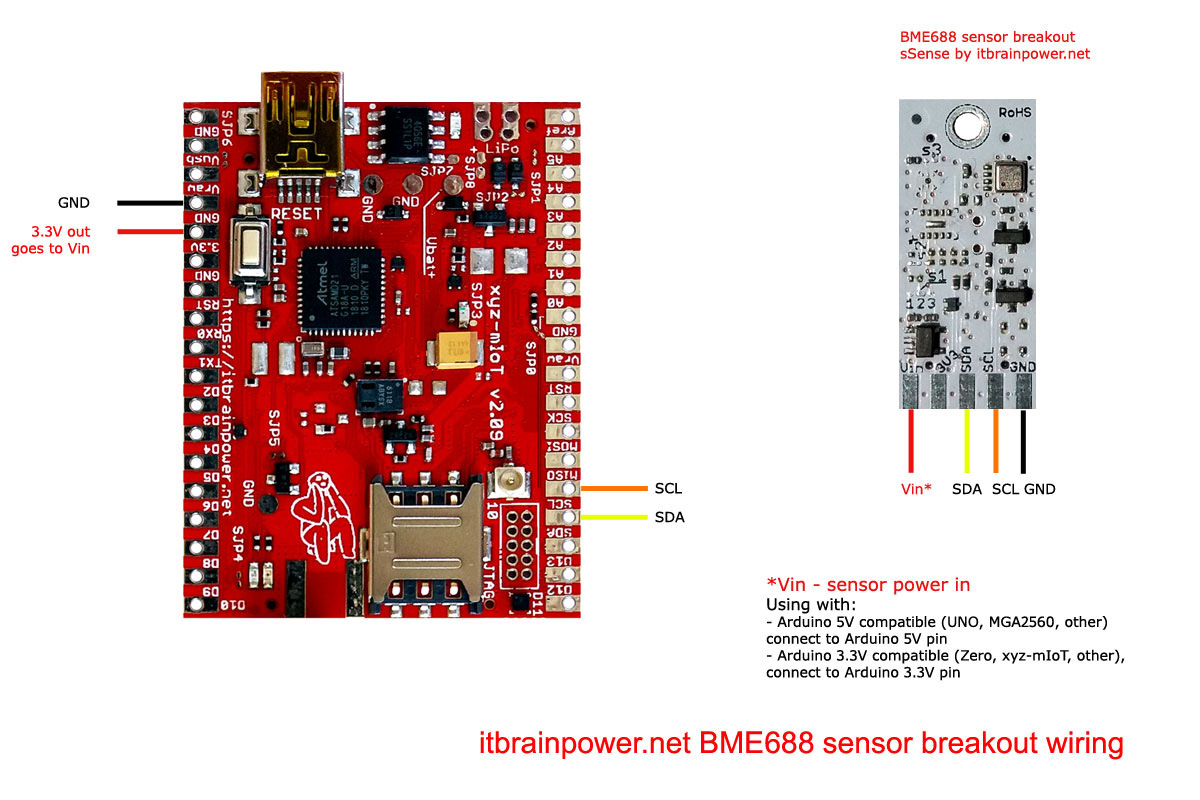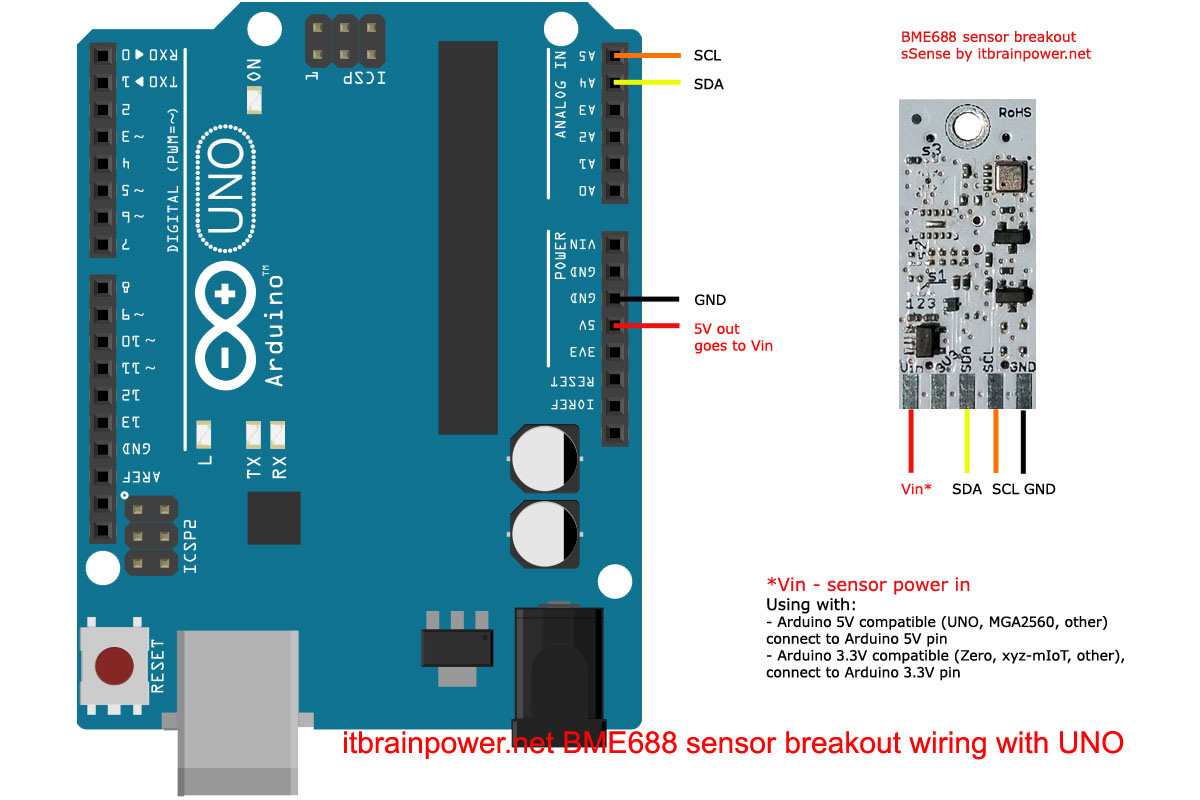About BME688 - gas scanner with AI, air quality sensor, temp., hum. and pres. sensor
BME688 ( manufactured by Bosch Sensortec) is the first gas sensor with Artificial Intelligence (AI) and integrated high-linearity and high-accuracy humidity and temperature sensors. The integrated gas sensor it's able to detect Volatile Organic Compounds (VOCs), Volatile Sulfur Compounds (VSCs) and other gases as carbon monoxide (CO) and hydrogen in the ppb (part per billion) range.
The new BME 688 sensor its backward compatible with BME680. Additionally, to all features of the BME680, the BME688 has a gas scanner function. In standard configuration, the presence of VSCs is detected as indicator for e.g. bacteria growth. The gas scanner can be customized with respect to sensitivity, selectivity, data rate and power consumption as well. The BME AI-Studio tool enables customers to train the BME688 gas scanner on their specific application, like in home appliances, IoT products or Smart Home.
The gas sensor in the BM688 has a broad sensitivity and reacts to most volatile compounds as well as many other gases polluting indoor air. The intensity of the signal typically scales with the chemical reactivity of the gases. In contrast to sensors selective for one specific component, the BME688 is capable of measuring the sum of VOCs/contaminants in the surrounding air. This enables the BME688 to detect e.g. out-gassing from paint, furniture and/or garbage, high VOC levels due to cooking, food consumption, exhaled breath and/or sweating.
Bosch Sensortec BME688 sensor main features:
- ambient range for operation -40 ~ +85C, 0%-100% r.H., 300-1100hPa
- gas sensor major outputs (via BSEC) IAQ, bVOC & CO2 equivalents (ppm), gas scan results (%) & intensity level
- sensor to sensor IAQ deviation +-15% / +-15IAQ
- relative humidity accuracy tolerance / hysteresis +-3% / <= 1.5%
- absolute temperature accuracy +-0.5C (at +25C)
- pressure sensitivity error +-0.25%
- BME688 datasheet
In June 2019 we've realeased the first 6 environmental and air quality sensors from the s-Sense I2C sensor breakout family. In the middle of May 2021, as soon as BME688 sensor become available, we released commercially our s-Sense BME688 breakout.
s-Sense BME688 sensor breakout by itbrainpower.net


PN: SS-BME688#I2C SKU: ITBP-6007 BME688 I2C sensor breakout more info ,order
Hints:
- at first sensor usage, minimum 48 hours of "burn in" should be made. Later, at each usage, 30 min. of functioning should passed before sensor data may be considered as valid.
- for IAQ (Air quality index), target gas scanner selectivity, VOC, VSC and other BME688 features may be accessed using the Bosch Sensortec "BSEC fusion library".
- in order to avoid contamination, DO NOT touch the metallic casing of the BME688!!!
Next, I will show to you how to make the hardware setup and how to get raw sensor (temperature, humidity, pressure and the MOX gas resistor) values in Arduino - around 10-15 minutes.
Arduino BME688 sensor hardware integration (wiring)
First, identify if your Arduino it's 5V or 3.3V compliant!
The BME688 I2C sensor breakout it's shipped in default auto 3-5V compliant configuration. In a nut shell, wire as bellow:
| BME688 breakout | Arduino 5V [Eg.: UNO] | Arduino 3.3V [Eg.: Zero] |
|---|---|---|
| Vin PAD | 5V | 3.3V |
| Vdd PAD (3V3) | do not connect | do not connect |
| SDA PAD | SDA | SDA |
| SCL PAD | SCL | SCL |
| GND PAD | GND | GND |
HINT, for some ARDUINO boards:
* SDA (Serial Data) --> A4 on Uno/Pro-Mini, 20 on Mega2560/Due, 2 Leonardo/Pro-Micro
* SCK (Serial Clock) --> A5 on Uno/Pro-Mini, 21 on Mega2560/Due, 3 Leonardo/Pro-Micro
Bellow, sensor wiring example with xyz-mIoT shield [AT SAMD21G, 3.3V compliant, with or without modems]:

Bellow, sensor wiring example with Arduino UNO shield [328p, 5 compliant]:

Arduino BME688 sensor software - read raw sensor data
a. download BME68x Arduino library from: here.
b. unzip the library and install in Arduino libraries folder. Restart Arduino.
c. Make a folder named "ssense_BME688_example".
Copy the code bellow, paste it one new file and save the file as "ssense_BME688_example.ino" in the folder created in previously or, you may
download it from here (right click & save as): BME688 - read sensor data Arduino code
| 1 | /* s-Sense BME68x I2C sensor breakout example - v1.01/20210520. |
| 2 | * |
| 3 | * Compatible with: |
| 4 | * s-Sense BME688 I2C sensor breakout - gas scanner with AI, air quality sensor, temperature, humidity and pressure sensor - [PN: SS-BME688#I2C, SKU: ITBP-6007, |
| 5 | * info https://itbrainpower.net/sensors/BME688 |
| 6 | * s-Sense BME680 I2C sensor breakout - temperature, humidity, pressure and gas - [PN: SS-BME680#I2C, SKU: ITBP-6003], |
| 7 | * info https://itbrainpower.net/sensors/BME680 |
| 8 | * |
| 9 | * This code shows how to use predefined recommended settings for the BME680 air quality sensor. Read temperature, |
| 10 | * humidity, pressure and gas sensor data (pulling at 1sec) - code based on based on Zanshin_BME680 library version |
| 11 | * 1.0.2 / 2019-01-26 - https://github.com/SV-Zanshin . Good job Zanshin! |
| 12 | * |
| 13 | * Include three functions for altitude calculation (one provided by Zanshin, one ported from BME280/BMP280 library [NOAA equation] and the |
| 14 | * last one [based on CASIO equation and implementing temperature compensated algorithm] that was written by us. |
| 15 | * |
| 16 | * We've just select the relevant functions, fixed some 328p compiling issues found in original library, add some variables, functions and fuctionalities. |
| 17 | * |
| 18 | * |
| 19 | * Mandatory wiring: |
| 20 | * Common for 3.3V and 5V Arduino boards: |
| 21 | * sensor I2C SDA <------> Arduino I2C SDA |
| 22 | * sensor I2C SCL <------> Arduino I2C SCL |
| 23 | * sensor GND <------> Arduino GND |
| 24 | * For Arduino 3.3V compatible: |
| 25 | * sensor Vin <------> Arduino 3.3V |
| 26 | * For Arduino 5V compatible: |
| 27 | * sensor Vin <------> Arduino 5V |
| 28 | * |
| 29 | * Leave other sensor PADS not connected. |
| 30 | * |
| 31 | * SPECIAL note for some ARDUINO boards: |
| 32 | * SDA (Serial Data) -> A4 on Uno/Pro-Mini, 20 on Mega2560/Due, 2 Leonardo/Pro-Micro |
| 33 | * SCK (Serial Clock) -> A5 on Uno/Pro-Mini, 21 on Mega2560/Due, 3 Leonardo/Pro-Micro |
| 34 | * |
| 35 | * WIRING WARNING: wrong wiring may damage your Arduino board MCU or your sensor! Double check what you've done. |
| 36 | * |
| 37 | * New BME688/680 sensors requires burn in (48h). Once burned in a sensor requires at least 5 minutes of run in before gas resistance readings are considered good. |
| 38 | * |
| 39 | * READ BME688 documentation! https://itbrainpower.net/sensors/BME688 |
| 40 | * READ BME680 documentation! https://itbrainpower.net/sensors/BME680 |
| 41 | * |
| 42 | * We ask you to use this SOFTWARE only in conjunction with s-Sense BME688 or s-Sense BME680 sensor(s) breakout usage. Modifications, derivates |
| 43 | * and redistribution of this SOFTWARE must include unmodified this notice. You can redistribute this SOFTWARE and/or modify it under the |
| 44 | * terms of this notice. |
| 45 | * |
| 46 | * This SOFTWARE is distributed is provide "AS IS" in the hope that it will be useful, but WITHOUT ANY WARRANTY; without even the implied warranty of |
| 47 | * MERCHANTABILITY or FITNESS FOR A PARTICULAR PURPOSE. |
| 48 | * |
| 49 | * itbrainpower.net invests significant time and resources providing those how to and in design phase of our IoT products. |
| 50 | * Support us by purchasing our environmental and air quality sensors from https://itbrainpower.net/order#s-Sense |
| 51 | * |
| 52 | * |
| 53 | * Dragos Iosub, Bucharest 2021. |
| 54 | * https://itbrainpower.net |
| 55 | */ |
| 56 | |
| 57 | /*! @file I2CDemo.ino |
| 58 | |
| 59 | |
| 60 | @section I2CDemo_intro_section Description |
| 61 | |
| 62 | Example program for using the Bosch BME680 sensor. The sensor measures temperature, pressure and humidity and is |
| 63 | described at https://www.bosch-sensortec.com/bst/products/all_products/BME680. The datasheet is available from Bosch |
| 64 | at https://ae-bst.resource.bosch.com/media/_tech/media/datasheets/BST-BME680_DS001-11.pdf \n\n |
| 65 | |
| 66 | The most recent version of the BME680 library is available at https://github.com/SV-Zanshin/BME680 and the |
| 67 | documentation of the library as well as example programs are described in the project's wiki pages located at |
| 68 | https://github.com/SV-Zanshin/BME680/wiki. \n\n |
| 69 | |
| 70 | The BME680 is a very small package so it is unlikely for an Arduino hobbyist to play around with directly, the |
| 71 | hardware used to develop this library is a breakout board from AdaFruit which is well-documented at |
| 72 | https://learn.adafruit.com/adafruit-BME680-humidity-barometric-pressure-temperature-sensor-breakout \n\n |
| 73 | |
| 74 | This example program initializes the BME680 to use I2C for communications. The library does not using floating |
| 75 | point mathematics to save on computation space and time, the values for Temperature, Pressure and Humidity are |
| 76 | returned in deci-units, e.g. a Temperature reading of "2731" means "27.31" degrees Celsius. The display in the |
| 77 | example program uses floating point for demonstration purposes only. Note that the temperature reading is |
| 78 | generally higher than the ambient temperature due to die and PCB temperature and self-heating of the element.\n\n |
| 79 | |
| 80 | The pressure reading needs to be adjusted for altitude to get the adjusted pressure reading. There are numerous |
| 81 | sources on the internet for formula converting from standard sea-level pressure to altitude, see the data sheet |
| 82 | for the BME180 on page 16 of http://www.adafruit.com/datasheets/BST-BMP180-DS000-09.pdf. Rather than put a |
| 83 | floating-point function in the library which may not be used but which would use space, an example altitude |
| 84 | computation function has been added to this example program to show how it might be done. |
| 85 | |
| 86 | @section I2CDemolicense License |
| 87 | |
| 88 | This program is free software: you can redistribute it and/or modify it under the terms of the GNU General |
| 89 | Public License as published by the Free Software Foundation, either version 3 of the License, or (at your |
| 90 | option) any later version. This program is distributed in the hope that it will be useful, but WITHOUT ANY |
| 91 | WARRANTY; without even the implied warranty of MERCHANTABILITY or FITNESS FOR A PARTICULAR PURPOSE. See the |
| 92 | GNU General Public License for more details. You should have received a copy of the GNU General Public License |
| 93 | along with this program. If not, see <http://www.gnu.org/licenses/>. |
| 94 | |
| 95 | @section I2CDemoauthor Author |
| 96 | |
| 97 | Written by Arnd\@SV-Zanshin |
| 98 | |
| 99 | @section I2CDemoversions Changelog |
| 100 | |
| 101 | Version | Date | Developer | Comments |
| 102 | ------- | ---------- | ------------------- | -------- |
| 103 | 1.0.1 | 2019-01-26 | https://github.com/SV-Zanshin | Issue #3 - convert documentation to Doxygen |
| 104 | 1.0.0b | 2018-06-30 | https://github.com/SV-Zanshin | Cloned from original BME280 program |
| 105 | |
| 106 | */ |
| 107 | |
| 108 | /******************************************************************************************************************* |
| 109 | ** ** |
| 110 | ** This program is free software: you can redistribute it and/or modify it under the terms of the GNU General ** |
| 111 | ** Public License as published by the Free Software Foundation, either version 3 of the License, or (at your ** |
| 112 | ** option) any later version. This program is distributed in the hope that it will be useful, but WITHOUT ANY ** |
| 113 | ** WARRANTY; without even the implied warranty of MERCHANTABILITY or FITNESS FOR A PARTICULAR PURPOSE. See the ** |
| 114 | ** GNU General Public License for more details. You should have received a copy of the GNU General Public License ** |
| 115 | ** along with this program. If not, see <http://www.gnu.org/licenses/>. ** |
| 116 | ** ** |
| 117 | ** Vers. Date Developer Comments ** |
| 118 | ** ====== ========== ============================= ============================================================== ** |
| 119 | ** 1.0.0b 2018-06-30 https://github.com/SV-Zanshin Cloned from original BME280 program ** |
| 120 | ** ** |
| 121 | *******************************************************************************************************************/ |
| 122 | #include "sSense_BME680.h" // Include the BME680 Sensor library |
| 123 | /******************************************************************************************************************* |
| 124 | ** Declare all program constants ** |
| 125 | *******************************************************************************************************************/ |
| 126 | |
| 127 | #define SERIAL_SPEED 19200//; ///< Set the baud rate for Serial I/O |
| 128 | /******************************************************************************************************************* |
| 129 | ** Declare global variables and instantiate classes ** |
| 130 | *******************************************************************************************************************/ |
| 131 | BME680_Class BME680; ///< Create an instance of the BME680 |
| 132 | |
| 133 | /*! |
| 134 | * @brief This converts a pressure measurement into a height in meters |
| 135 | * @details The corrected sea-level pressure can be passed into the function if it is know, otherwise the standard |
| 136 | * atmospheric pressure of 1013.25hPa is used (see https://en.wikipedia.org/wiki/Atmospheric_pressure |
| 137 | * @param[in] seaLevel Sea-Level pressure in millibars |
| 138 | * @return floating point altitude in meters. |
| 139 | */ |
| 140 | float altitude(const float seaLevel=1013.25) |
| 141 | { |
| 142 | /*wikipedia equation - original Zanshin code*/ |
| 143 | static float Altitude; |
| 144 | int32_t temp, hum, press, gas; |
| 145 | BME680.getSensorData(temp,hum,press,gas); // Get the most recent values from the device |
| 146 | Altitude = 44330.0*(1.0-pow(((float)press/100.0)/seaLevel,0.1903)); // Convert into altitude in meters |
| 147 | return(Altitude); |
| 148 | } // of method altitude() |
| 149 | |
| 150 | float calculate_altitude( float pressure, bool metric = true, float seaLevelPressure = 101325) |
| 151 | { |
| 152 | /*Equations courtesy of NOAA - code ported from BME280*/; |
| 153 | float altitude = NAN; |
| 154 | if (!isnan(pressure) && !isnan(seaLevelPressure)){ |
| 155 | altitude = 1000.0 * ( seaLevelPressure - pressure ) / 3386.3752577878; |
| 156 | } |
| 157 | return metric ? altitude * 0.3048 : altitude; |
| 158 | } |
| 159 | |
| 160 | float temperatureCompensatedAltitude(int32_t pressure, float temp=21.0 /*Celsius*/, float seaLevel=1013.25) |
| 161 | { |
| 162 | /*Casio equation - code written by itbrainpower.net*/ |
| 163 | float Altitude; |
| 164 | Altitude = (pow((seaLevel/((float)pressure/100.0)), (1/5.257))-1)*(temp + 273.15) / 0.0065; // Convert into altitude in meters |
| 165 | return(Altitude); //this are metric value |
| 166 | } |
| 167 | |
| 168 | |
| 169 | /*! |
| 170 | @brief Arduino method called once at startup to initialize the system |
| 171 | @details This is an Arduino IDE method which is called first upon boot or restart. It is only called one time |
| 172 | and then control goes to the main "loop()" method, from which control never returns |
| 173 | @return void |
| 174 | */ |
| 175 | void setup() |
| 176 | { |
| 177 | DebugPort.begin(SERIAL_SPEED); // Start serial port at Baud rate |
| 178 | |
| 179 | while(!DebugPort) {delay(10);} // Wait |
| 180 | |
| 181 | //delay(1000); |
| 182 | |
| 183 | DebugPort.println("s-Sense BME68x I2C sensor."); |
| 184 | DebugPort.print("- Initializing BME68x sensor\n"); |
| 185 | while (!BME680.begin(I2C_STANDARD_MODE)) // Start BME68x using I2C protocol |
| 186 | { |
| 187 | DebugPort.println("- Unable to find BME68x. Waiting 1 seconds."); |
| 188 | delay(1000); |
| 189 | } // of loop until device is located |
| 190 | DebugPort.println("- Setting 16x oversampling for all sensors"); |
| 191 | BME680.setOversampling(TemperatureSensor,Oversample16); // Use enumerated type values |
| 192 | BME680.setOversampling(HumiditySensor, Oversample16); |
| 193 | BME680.setOversampling(PressureSensor, Oversample16); |
| 194 | DebugPort.println("- Setting IIR filter to a value of 4 samples"); |
| 195 | BME680.setIIRFilter(IIR4); |
| 196 | DebugPort.println("- Setting gas measurement to 320C for 150ms"); |
| 197 | BME680.setGas(320,150); // 320�c for 150 milliseconds |
| 198 | DebugPort.println(); |
| 199 | } // of method setup() |
| 200 | |
| 201 | /*! |
| 202 | @brief Arduino method for the main program loop |
| 203 | @details This is the main program for the Arduino IDE, it is an infinite loop and keeps on repeating. |
| 204 | @return void |
| 205 | */ |
| 206 | void loop() |
| 207 | { |
| 208 | //static uint8_t loopCounter = 0; |
| 209 | static int32_t temperature, humidity, pressure, gas; // Variable to store readings |
| 210 | BME680.getSensorData(temperature,humidity,pressure,gas); // Get most recent readings |
| 211 | DebugPort.print("\r\nSensor data >>\t\t"); // Temperature in deci-degrees |
| 212 | DebugPort.print(temperature/100.0,2); // Temperature in deci-degrees |
| 213 | DebugPort.print("C\t"); |
| 214 | DebugPort.print(humidity/1000.0,2); // Humidity in milli-percent |
| 215 | DebugPort.print("%\t"); |
| 216 | DebugPort.print(pressure/100.0,2); // Pressure in Pascals |
| 217 | DebugPort.print("hPa\t"); |
| 218 | //DebugPort.print(pressure); // Pressure in Pascals |
| 219 | //DebugPort.print("Pa "); |
| 220 | DebugPort.print(gas/100.0,2); |
| 221 | DebugPort.println("mOhm"); |
| 222 | |
| 223 | DebugPort.println("\r\nCalculated altitude"); |
| 224 | |
| 225 | DebugPort.print("temp comp [CASIO equation]: "); |
| 226 | |
| 227 | //temperatureCompensatedAltitude(int32_t pressure, float temp =21.0, const float seaLevel=1013.25) |
| 228 | DebugPort.print(temperatureCompensatedAltitude(pressure, temperature/100.0/*, 1022.0*/),2); |
| 229 | DebugPort.print("m\t"); |
| 230 | |
| 231 | |
| 232 | DebugPort.print("NOAA equation: "); |
| 233 | |
| 234 | //float calculate_altitude( float pressure, bool metric = true, float seaLevelPressure = 101325) |
| 235 | DebugPort.print(calculate_altitude((long)pressure,true),2); //calculate_altitude |
| 236 | //DebugPort.print(calculate_altitude((long)pressure,true, (long)102200.0),2); //calculate_altitude |
| 237 | DebugPort.print("m\t"); |
| 238 | |
| 239 | DebugPort.print("WIKI equation: "); |
| 240 | DebugPort.print(altitude(),2); |
| 241 | DebugPort.println("m \r\n"); |
| 242 | /* |
| 243 | Temp: 33.03C Humidity: 42.03% RH Pressure: 101058.02 Pa |
| 244 | Altitude: 78.84m Dew point: 12.43C Equivalent Sea Level Pressure: 101950.37 Pa |
| 245 | |
| 246 | Temp: 33.01C Humidity: 40.75% RH Pressure: 101051.84 Pa |
| 247 | Altitude: 80.66m Dew point: 11.71C Equivalent Sea Level Pressure: 101964.92 Pa |
| 248 | |
| 249 | Temp: 32.98C Humidity: 40.24% RH Pressure: 101055.34 Pa |
| 250 | Altitude: 79.63m Dew point: 11.40C Equivalent Sea Level Pressure: 101956.80 Pa |
| 251 | */ |
| 252 | delay(1000); |
| 253 | } // of method loop() |
| 254 |
c'. The very same code it's available in Arduino "File-> Examples", under "ssense-BME68x" library.
d. Compile and upload the code to your Arduino shield. The sensor data may be seen on Arduino Serial Monitor (set to 19200bps).
Advanced sensor data interpretation - altitude calculation. We've included 3 variants:
- very basic algorithm,
- NOAA based algorithm (function ported from BME280/BMP280 Arduino library),
- CASIO altitude calculation implementation - most accurate altitude calculation based on temperature compensated algorithm...
TUTORIAL PROVIDED WITHOUT ANY WARRANTY!!! USE IT AT YOUR OWN RISK!!!!